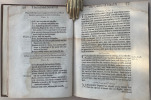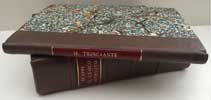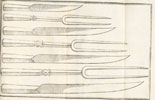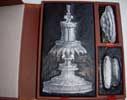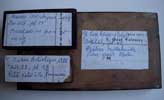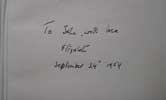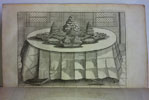TWENTY-FIVE ITEMS; BOOKS, BOOKLETS, CATALOGUES AND MAGAZINES.
9 BOOKLETS - 1. Green Pepper Berries (very rare). 2. English Potted Meats & Fish Pastes. 3. Syllabubs & Fruit Fools. 4. The Baking of an English Loaf. 5. Dried Herbs, Aromatics & Condiments. 6. The Use of Wine in Italian Cooking. 7. Entertaining with Grand Marnier. 8. 1st Edition 1963. 16 pages. 'Cooking with Le Creuset' (very rare). 9. Later & enlarged edition. Ring bound 38 pages. Cooking with Le Creuset. 1. BOOK. Classic Indian Vegetarian Cooking by Julie Sahni. 621 pages. With a letter from the publisher, Maria Guarnaschelli of William Morrow & Co. of New York. Asking E.D. to read the book and give her opinion. E.D. numbered the pages and wrote the 24 substantial points of critique on the back of the letter in ink. E.D. must have typed out her critical points and sent them to Maria Guarnaschelli. The points were sent Julie Sahni who responded back to E.D. as there is a further typed reply from E.D. (not signed). It also appears in the reply that E.D. appreciated and rated Sahni's book very highly. 1. AUCTION CATALOGUE. To be sold by Auction at Phillips of Bayswater on Tuesday, February 22nd, 1994 at 12 noon. This was a very well attended sell-off of E.D's house contents after her death in 1992. 1. Beautifully designed 4 page thick paper E.D. Memorial Service booklet. The front and back covers are a reprint of John Minton's dust wrapper for French Country Cooking. With the full service schedule and list of appreciations. 2. E.D. SHOP CATALOGUES. 1967-8. 1 finished equipment catalogue of 20 Pages. 2. E.D's working catalogue copy with all the extensive notations and changes in her hand. (very rare) 4. E.D. SHOP CATALOGUES & ONE ENVELOPE. 1. Kitchen Utensils. Price List 1968-9. E.D's own copy with all the new prices stuck on. 2. Summer Cooking 1968: A large A3 glossy catalogue folded into 8 pages of Kitchen Utensils and Prices. 3. Another glossy working catalogue of 20 pages of equipment and prices. Some pages empty. 4. In a brown envelope addressed to the shop form the Printer. A note in green ink in E.D's own hand informing its E.D's own copy. 1. WINE & FOOD MAGAZINE. February/March 1969. (E.D's Members copy.) With a 4 page article by E.D. specifically with recipes for Lemons. A further 2 page article about Kitchen knives that were sold in E. D's shop at 46 Bourne St. London S.W.1. An interesting read. 1. SUNDAY TIMES MAGAZINE. October 31st 1965. A 2 page article about E.D's shop opening the next day on November 1st. There is also a large 2 page photograph of E.D's kitchen in her house. 1. LARGE FORMAT 1st DRAFT WORKING COPY. Of equipment lists with annotations in E.D's hand. 9 BOOKLETS - 1. Green Pepper Berries (very rare). 2. English Potted Meats & Fish Pastes. 3. Syllabubs & Fruit Fools. 4. The Baking of an English Loaf. 5. Dried Herbs, Aromatics & Condiments. 6. The Use of Wine in Italian Cooking. 7. Entertaining with Grand Marnier. 8. 1st Edition 1963. 16 pages. Cooking with Le Creuset. (very rare). 9. Later & enlarged edition. Ring bound 38 pages. Cooking with Le Creuset. 1. BOOK. Classic Indian Vegetarian Cooking by Julie Sahni. 621 pages. With a letter from the publisher, Maria Guarnaschelli of William Morrow & Co. of New York. Asking E.D. to read the book and give her opinion. E.D. numbered the pages and wrote the 24 substantial points of critique on the back of the letter in ink. E.D. must have typed out her critical points and sent them to Maria Guarnaschelli. The points were sent Julie Sahni who responded back to E.D. as there is a further typed reply from E.D. (not signed). It also appears in the reply that E.D. appreciated and rated Sahni's book very highly. 1. AUCTION CATALOGUE. To be sold by Auction at Phillips of Bayswater on Tuesday, February 22nd, 1994 at 12 noon. This was a very well attended sell-off of E.D's house contents after her death in 1992. 1. Beautifully designed 4 page thick paper E.D. Memorial Service booklet. The front and back covers are a reprint of John Minton's dust wrapper for French Country Cooking. With the full service schedule and list of appreciations. 2. E.D. SHOP CATALOGUES. 1967-8. 1 finished equipment catalogue of 20 Pages. 2. E.D's working catalogue copy with all the extensive notations and changes in her hand. (very rare) 4. E.D. SHOP CATALOGUES & ONE ENVELOPE. 1. Kitchen Utensils. Price List 1968-9. E.D's own copy with all the new prices stuck on. 2. Summer Cooking 1968: A large A3 glossy catalogue folded into 8 pages of Kitchen Utensils and Prices. 3. Another glossy working catalogue of 20 pages of equipment and prices. Some pages empty. 4. In a brown envelope addressed to the shop from the Printer. A note in green ink in E.D's own hand informing its E.D's own copy. 1. WINE & FOOD MAGAZINE. February/March 1969. (E.D's Members copy.) With a 4 page article by E.D. specifically with recipes for Lemons. A further 2 page article about Kitchen knives that were sold in E. D's shop at 46 Bourne St. London S.W.1. An interesting read. 1. SUNDAY TIMES MAGAZINE. October 31st 1965. A 2 page article about E.D's shop opening the next day on November 1st. There is also a large 2 page photograph of E.D's kitchen in her house. 1. LARGE FORMAT 1st DRAFT WORKING COPY. Of equipment lists with annotations in E.D's hand.
All the above in fine condition and housed in a specially made box with leather spine, gilt tooling and morocco leather labels.
- Further to Elizabeth David's famous published cookery books, she continued to produce many small specialized recipe booklets, written multi-media articles etc. She also owned a kitchen equipment shop in Pimlico. The items assembled here over many years is a comprehensive collection of all aspects of her phenomenal output besides her books.

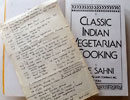
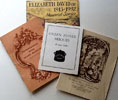

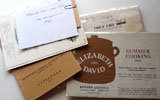
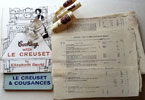
click on image to enlarge

Ephemera category
ref number:
11180 




